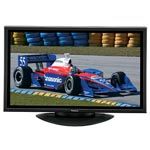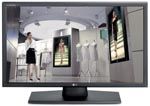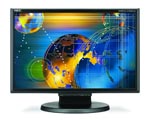A very interesting phenomenon is taking place in the world of flat panel displays. The ongoing battle of technologies is being "won" by the LCD camp over what most display experts consider the superior performance of plasma display technology.
Before a war of words ensues over the use of the term "superior," please permit me, as an agnostic display technologist, to point out that plasma technology can in fact offer deeper, richer color saturation due to the incorporation of rare earth phosphors as the color creation medium. In addition, plasma displays can offer better contrast ratios due to their inherent emissive rather than transmissive approach, and finally they can provide quicker response times than comparable LCD flat panel displays.
Some will say they prefer the look of LCD over plasma and vice versa. My answer to which one is best is a simple and definitive, "You are correct whichever one you prefer." You may prefer a more digital look from LCD displays, or the more film-like or CRT look of plasmas. Perception is your reality.
In fact, LCD manufacturers are getting much closer to the look and feel produced by plasma displays. Color saturation is improving, as is contrast, and the new, faster panels at eight milliseconds or less are outstanding. But the fact remains that plasma has the video picture performance edge and up until recently, the edge in sales in the 32-inch and larger panel size market.
Change Is Inevitable
This new market dynamic really started three or four years ago, when plasma displays had the large flat panel market to themselves. They practically owned the 37-inch and larger segment, and it seemed as if the development of larger LCD panels would fall victim to excessive manufacturing costs and yield issues, not to mention performance limitations, forcing them to be higher-priced than comparable plasma displays. If we recall only a couple of years ago, a new 40-inch LCD was 30 percent higher in street price than a name-brand 42-inch plasma, and the performance was nowhere near as good from a video picture point of view. The plasma camp was secure and all was well-or so they thought.
Over the last 18 months we have seen a significant drop of 25 to 30 percent in flat panel prices in both the LCD and plasma displays, and over the last 12 months, LCD displays in the 32- to 46-inch sizes have outsold plasma for the first time. There is speculation that the larger sizes of plasma in the 50-inch and larger categories may soon become vulnerable to LCD price parity as well. Most of us were shocked during the last holiday season at Panasonic's decision to sell its 42-inch plasma displays at just under $1,000 at special sales events. Special event or not, this threw down the gauntlet and set the price of that display size in the mind of the consumer.
Facts And Figures
If we look at the global electronic display market, it is expected to exceed $100 billion in revenue this year, marking a major milestone for the industry, according to Paul Semenza, vice president of display research for iSuppli. He recently spoke at the Society for Information Display (SID) 2007 and predicted the display market, consisting of flat-panel, projection, and some remaining CRT products, will reach $104.3 billion in revenue in 2007, up eight percent from $96.5 billion in 2006.
Semenza explained that the booming market for TFT-LCD screens is driving the growth in the display industry. "This is the dominant technology in the market and it's rising faster than the display industry as a whole," Semenza said. "TFT-LCD represents three-quarters of the display market and is in every major application one can think of."
According to Semenza and iSuppli, global TFT-LCD revenue surpassed $70 billion in 2006, accounting for 73 percent of display industry revenue. He opined that with TFT-LCD "solidifying its hold on the display market, other technologies have been relegated to niches." iSuppli forecasts that LCDs will account for 65 percent of all TV displays in 2011, up from 11 percent in 2005.
All of this growth is not without concerns. Semenza stated that "LCD-TV has had such a rapid growth rate in the TV market and penetrated so successfully that it will be harder to generate revenue growth going forward. Furthermore, a major question is: What is the maximum size of TV that a significant segment of consumers will want? The LCD-TV market has grown by migrating users to larger screen sizes. This has been very successful, but this strategy could generate challenges going forward."
The Race Isn't Over
Over the last year, both plasma and LCD have enjoyed significant gains in sales, but the rate of gain for plasma is being eclipsed by the progress of LCD sales into both consumer and commercial applications. The bottom line is that LCD is in the spotlight. The proof is in the sales numbers and the "buzz" generated by new, better products from major manufacturers.
The LCD crowd is rapidly catching up in size and quality to confront plasma, and while the 50-inch and larger LCD displays are still considerably more expensive than their PDP brethren, just remember, only a few short months ago plasma had the 37-inch and larger market to themselves and LCD was considerably higher in the 40-inch versus 42-inch battle. Stay tuned as the struggle to dominate continues.
New Flat Panels 2007
- NEC Display Solutions of America has added two new MultiSync 5 Series LCD monitors to its widescreen display portfolio. The new models include the 20-inch MultiSync LCD205WXM and the 22-inch LCD225WXM. The new widescreen additions deliver improved productivity and enhanced performance. Both new displays are Windows Vista-certified and designed to fit the needs of business users with new height adjustable stands, swivel bases, lightning fast 5- millisecond response times, high contrast ratios of 1000:1, 1680 x 1050 native resolutions, and wide viewing angles up to 176 degrees.
Planar Systems Clarity m57L is a large format direct-view LCD monitor designed for high definition control room applications. It combines leading-edge resolution, high reliability, and long-life expectancy in a thin monitor that is ideal for displaying mission-critical data. The m57L features 57-inch screen, high definition 1080p, direct-view LCD, long life, and an auto ambient light sensor. It also has a 4-inch deep, low power, integrated wall mount.

Sharp PN-G655U
The PN-G655U 65-inch monitor is designed for landscape operation. With a full 1920 x 1080 two-megapixel high-definition resolution and a 2000:1 contrast ratio, the monitor offers accurate and precise image reproduction and a bright picture in virtually any lighting condition. The monitor offers reliability for extended use applications. To show multiple types of content sources in high definition, the monitor utilizes DFE technology, which provides display of both digital and analog sources so the customer can display computer and video content.

Panasonic TH-42PHD8GK/S
Panasonic's 42 inch Hospitality series HD plasma display has up to 8.58 billion colors and a 3000:1 contrast ratio. With an aspect ratio of 16:9 and a native resolution of 1024 x 768, the TH-42PHD8GK/S will fit into many applications. The viewing angle is at more than 160 degreeswith a real MACH system and real black drive system. Both models come standard with PC input, audio input, and serial control (RS-232C) input. You can mount up to three optional boards.

LG M42110-BA LCD
Completing LG's full lineup of flat-screen technologies for the lodging industry are LG's new digital signage solutions for hotel lobbies, restaurants, convention venues, and public areas. LG's new M4210C-BA 42-inch LCD monitor is optimized for digital signage applications. Capable of portrait or landscape orientation, this screen has a narrow bezel of 29mm, which enhances the use of a 4x4 videowall application. Additionally, with LG's built-in IP Solution technology, hotels are able to deliver video content to multiple locations from one centralized video content and display control.
Samsung DisplayPort LCD
Samsung Electronics has developed an LCD panel using the next-generation video interface DisplayPort. Sanctioned by VESA (the Video Electronics Standards Association), DisplayPort will serve as a replacement for DVI, LVDS, and eventually VGA. For Samsung's new 30-inch LCD, the DisplayPort interface transmits graphics data at a total data rate of 10.8 Gbps. This speed enables 2560 x 1600 resolution without any color smear. By using a transmission speed more than double that of regular interfaces, Samsung's new LCD only requires a single DisplayPort interface, instead of the two DVI ports now used.










